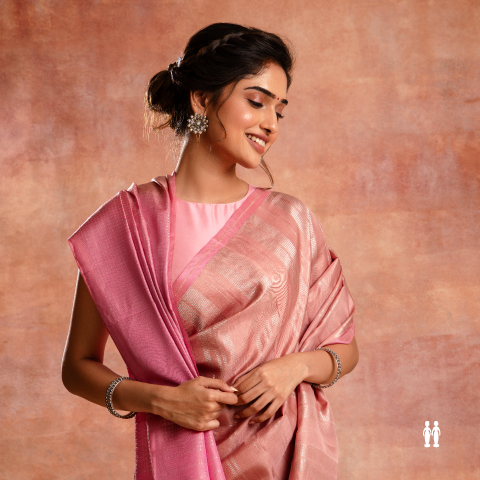From borders to patterns and colours to craftsmanship, the saree is a canvas for masterpieces steeped in the rich legacy of our traditions. The unstitched fabric is an Indian icon and holds within its folds the wisdom of our glorious past and the key to an abundance of possibilities. The origin of a saree can be traced back to the times of the Indus Valley Civilization, which flourished in the Indian subcontinent from 2,800 to 1,800 BC, and has records of women wearing a drape-like attire. And this extends to the Vedas, one of the oldest literary works of our civilization which trace the evolution of the saree, as well as its strong ties with society. For a country with diverse and dynamic cultures, a single piece of cloth has been the unifying force throughout the years.
India is home to over 100+ draping styles, each of which is unique, right from the pleats to the pallu to the purpose. Draping this great Indian fabric is as much an art as weaving it. Let us traverse through the length and breadth of our country and to learn more about some of the traditional draping styles from each state.
Athpourey Shari (West Bengal)
India is home to over 100+ draping styles, each of which is unique, right from the pleats to the pallu to the purpose. Draping this great Indian fabric is as much an art as weaving it. Let us traverse through the length and breadth of our country and to learn more about some of the traditional draping styles from each state.
Athpourey Shari (West Bengal)
It is characterised by box pleats in the front and pallu draped over both shoulders from the back. A prevalent practice is for the women to tie the house keys to the pallu end as signifies her position of pride as the head of the household.
Nauvari (Maharashtra)
Draped using a nine-yard saree, it is worn like a dhoti between the legs, tucked around the waist and resembles a regular pleating style in the upper part. Besides being extremely elegant, it allows for easy leg movement as seen in the traditional 'Lavani' folk dance.
Kappulu (Andhra Pradesh)
Predominantly worn by older women, it is wrapped from left to right, unlike other drapes. It is distinguished by the narrow pleats at the back and the dual cloth cascades achieved by twisting the ends twice around the body. The pallu is either left to hang loose or is around the neck.

Mekhela Chadar (Assam)
A name common to both the draping style and the Assamese handloom weave, it is made up of 2 pieces. The bottom one is worn like a sarong with criss-cross pleats at the front and the upper one is tucked on the left side of the waist and draped like a shawl over the shoulder.
Madisaru (Tamil Nadu)
An important part of the regional culture and customs, especially marriages, it is one of the toughest draping styles which when done correctly does not require a blouse or petticoat. It follows the 'Ardhanareeshwara' style (half-masculine and half-feminine), where the lower half is tied like a dhoti and the upper half is pleated like a saree.
Seedha Pallu (Gujarat, Uttar Pradesh and Odisha)
Preferred style by the folk women, it is draped in a way that it resembles the lehenga choli, where the pallu replaces the dupatta. Apart from offering free hand movements to work, when the pallu is draped in the front it helps showcase its intricate handiwork.

Surguja (Chhattisgarh)

Surguja (Chhattisgarh)
A speciality style of the dancers from Chattisgarh's Oraon community, it makes use of 5.3-yard saree to create a whirling effect where the loose ends are tucked in the front and back. The pallu is draped over the right shoulder twice and in between over the head.
Halakki Vokkaliga (Karnataka)
A drape that carries a legacy of centuries, it is most commonly seen in the Western Ghat regions. Both ends of the saree are tied around the neck and then wrapped around the body like a sarong. Handcrafted beaded jewellery and colourful flowers are paired along with it.
Kunbi (Goa)
Backed by an equal mix of Portuguese and Konkani influence, this style is adopted in 2 different ways by the local communities. The base is made up of wrapping the saree around the waist, above the ankles and knotting it on the right shoulder.
For each of these timeless draping styles to be perfect, each region has its own speciality of saree, made with indigenous fabrics and inherited embellishment techniques. At Sundari Silks, we take immense pride in bringing forth our country's prized handloom weaves to the world, through our vast and varied collection of weaves. Stay tuned as we delve into more such unique and traditional draping styles over the next few weeks.
For each of these timeless draping styles to be perfect, each region has its own speciality of saree, made with indigenous fabrics and inherited embellishment techniques. At Sundari Silks, we take immense pride in bringing forth our country's prized handloom weaves to the world, through our vast and varied collection of weaves. Stay tuned as we delve into more such unique and traditional draping styles over the next few weeks.






